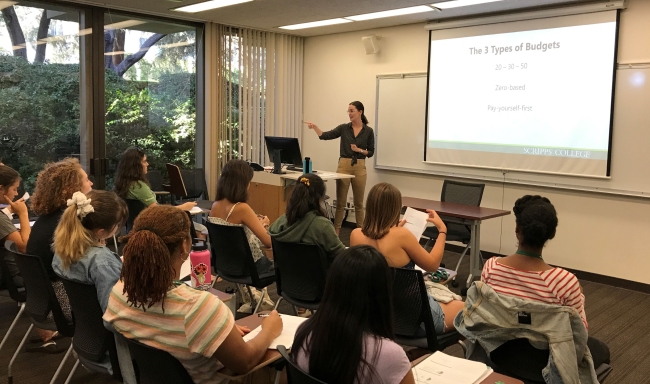You have /5 articles left.
Sign up for a free account or log in.

Budgeting is one of the four core topics in Scripps College’s financial literacy program.
Scripps College
Budgeting, banking and other areas of personal finance are a lot less stressful for individuals with jobs that pay a good wage—yet college financial literacy programs tend to focus on working with what you’ve got more than on winning a healthier paycheck.
Scripps College in Claremont, Calif., bundles a salary negotiation workshop with its four-module Financial Literacy Program. The workshop is taught by career planning professionals with training in using the Start Smart curriculum endorsed and provided the American Association of University Women, AAUW, while officials tap alumnae of the women’s institution to teach the core financial literacy components.
What’s the need: The benefactor of the Scripps program, former Board of Trustees chair Linda Davis Taylor, “believes in the power of financial literacy to transform a person’s life, and also the power of women sharing this information with other women,” says Gretchen Maldonado, interim director of the Laspa Center for Leadership at the college. Center staff developed and manage the core modules, in partnership with Career Planning and Resources.
Both men and women may hesitate on asking for higher salaries, particularly when right out of college. An early 2023 survey of 900 college seniors found that 52 percent didn’t plan to negotiate their first salary offer, even if it was lower than expected.
The longtime gender wage gap adds to the need for salary negotiation skills. According to U.S. Bureau of Labor Statistics data, women working full-time in wage and salary jobs had median usual weekly earnings of $996 in the first quarter of 2023—84 percent of men’s earnings, $1,186.
“We need to believe in ourselves,” says Maldonado. Sharing financial wisdom with others builds confidence for both the educator and the learner.
“In our college, there’s a strong emphasis on community and connections, and on connecting students with alumnae,” she adds.
How it works: Financial literacy sessions, offered each fall and spring since the program’s launch in spring 2019, are facilitated by Scripps alumnae and open to all currently enrolled students and community members of the Claremont Colleges. Initially taught in person by local alums, the sessions moved to Zoom in 2020. That proved to be a positive, as now alumnae can volunteer regardless of where they live.
While the facilitators—who receive an honorarium of $150 for leading a module or $100 if co-facilitating—are provided with the curriculum, alumnae must be comfortable with the subject matter, says Maldonado. “We don’t just throw it open to anyone.” Many of them work in financial services, but the program allows volunteers working in any field with any type of degree.
The one-hour modules cover:
- Basic budgeting (benefits of saving and investing, setting financial goals, etc.)
- Paychecks and taxes (net income estimating, employment benefits, federal income taxes, etc.)
- Banking, credit and loans (bank account fundamentals, credit history implications, fixed versus variable interest rates, etc.)
- Investments (role of personal values in long-term investments, retirement options, stocks, bonds, mutual funds, etc.)
The salary negotiation workshop, which already existed at the career center, was folded into the financial literacy program at its launch. If students, especially graduating seniors, aren’t thinking about how “their first salary in their first position can dictate the earnings ladder for their career, they’re missing a fundamental piece,” says Maldonado.
Salary negotiation basics: Besides gaining confidence in negotiating, workshop participants learn to identify and articulate their personal values, conduct objective market research and benchmark a target salary and benefits. Students are taught why they’ll need to pass on a role if the salary can’t provide what they need to live on, she adds.
Participants get real-time coaching and feedback on negotiation exercises, including how jobs ads with a salary range can shift the process and how finding solid salary information based on the industry, role and/or company can help.
“A lot of the hesitation we see with young women is ‘I’m afraid to ask, afraid the offer will go away,’” says Maldonado. She has reminded students that if the employer has “gotten to the point of offering you a position, they have invested a lot in you as an applicant. And it will take a lot to torpedo this.”
Students learn to negotiate through discomfort—and gain perspective on defining negotiation success. “Is it a 30 percent pay bump? Or that you made a case for what you think you’re worth, whether you get it or not?” she explains. “And next time you may succeed.” Not to mention, asking professionally and politely, with research clearly having been done—leaves a positive impression.
Helping students establish realistic expectations while ensuring they believe in themselves is the key. Instructors might bring up a recent survey showing how what college grads expect from a first job’s salary may be much higher than actual averages. Students need perspective on “here’s the rumor and here’s the reality behind it,” Maldonado says.
Students seem to embrace the opportunity to learn. “The idea that in 90 minutes we’re going to give them everything they need to know to negotiate is not realistic,” she explains. “Students appreciate knowing what’s going to be on the table, what is a reasonable ask.”
Campus partnership perspective: The workshop is some students’ first exposure to the career center. In that regard, the partnership between the two departments has allowed the career center to expand its reach on programming that already existed. Leadership and career development are “like cousins,” says Maldonado. “It’s about choice and fit, and how and why you want to apply your energy and talents in a particular area.”
Also, she quips, the partnership was an easy one because the departments are next-door neighbors, with the career center director’s office located right behind her own office wall.
Participation and evaluation: With undergraduate enrollment of only about 1,100 or 1,200, Scripps doesn’t tend to have huge participation numbers for anything voluntary. “Eleven is a healthy showing, and 15 people is a stampede,” Maldonado says, noting that the follow-through is there, however. “We’ve never had a no-show.” For reasons unknown, participants are most likely to be first-year students or seniors.
Annually, the program team assesses the program over all, and currently the team is collecting specific content feedback. “We’re looking at this summer as an opportunity to take a step back and see if the modules we have are covering everything we’d like them to,” she says. And are there areas that can be cut back? For example, is the banking module getting too far into the weeds on balancing a checkbook?
Also under consideration, based on facilitator feedback, is building out some advanced segments geared toward alumnae—such as buying a home or the financial implications of having children.
What others should know: For other institutions adding or tweaking financial literacy offerings, Maldonado advises looking to graduates. “Don’t underestimate the expertise that may already exist within the alumni community. Look at it as a win-win for both: more alumni engagement and more student engagement.”




